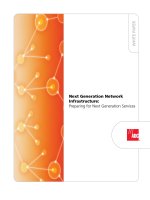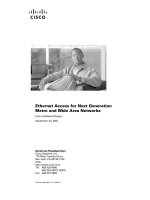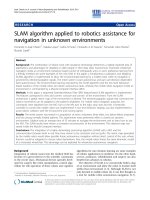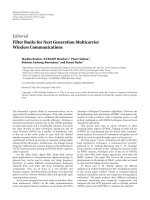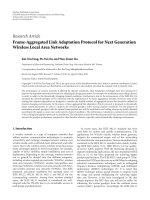Mobile peer to peer computing for next generation distributed environments advancing conceptual and algorithmic applications
Bạn đang xem bản rút gọn của tài liệu. Xem và tải ngay bản đầy đủ của tài liệu tại đây (20.01 MB, 561 trang )
Mobile Peer-to-Peer
Computing for Next
Generation Distributed
Environments:
Advancing Conceptual and
Algorithmic Applications
Boon-Chong Seet
Auckland University of Technology, New Zealand
InformatIon scIence reference
Hershey • New York
Director of Editorial Content:
Senior Managing Editor:
Managing Editor:
Assistant Managing Editor:
Typesetter:
Cover Design:
Printed at:
Kristin Klinger
Jamie Snavely
Jeff Ash
Carole Coulson
Chris Hrobak
Lisa Tosheff
Yurchak Printing Inc.
Published in the United States of America by
Information Science Reference (an imprint of IGI Global)
701 E. Chocolate Avenue,
Hershey PA 17033
Tel: 717-533-8845
Fax: 717-533-8661
E-mail:
Web site: />and in the United Kingdom by
Information Science Reference (an imprint of IGI Global)
3 Henrietta Street
Covent Garden
London WC2E 8LU
Tel: 44 20 7240 0856
Fax: 44 20 7379 0609
Web site:
Copyright © 2009 by IGI Global. All rights reserved. No part of this publication may be reproduced, stored or distributed in any form or by
any means, electronic or mechanical, including photocopying, without written permission from the publisher.
Product or company names used in this set are for identification purposes only. Inclusion of the names of the products or companies does
not indicate a claim of ownership by IGI Global of the trademark or registered trademark.
Library of Congress Cataloging-in-Publication Data
Mobile peer-to-peer computing for next generation distributed environments: advancing conceptual and algorithmic applications / Boon-Chong
Seet, editor.
p. cm.
Includes bibliographical references and index.
Summary: "This book is dedicated to the coverage of research issues, findings, and approaches to Mobile P2P computing from both conceptual
and algorithmic perspectives"--Provided by publisher.
ISBN 978-1-60566-715-7 (hbk.) -- ISBN 978-1-60566-716-4 (ebook) 1. Peer-to-peer architecture (Computer networks) 2. Mobile
communication systems. I. Seet, Boon-Chong, 1973TK5105.525.M63 2009
004.6'52--dc22
2009001030
British Cataloguing in Publication Data
A Cataloguing in Publication record for this book is available from the British Library.
All work contributed to this book is new, previously-unpublished material. The views expressed in this book are those of the authors, but not
necessarily of the publisher.
Editorial Advisory Board
Ouri Wolfson, University of Illinois at Chicago, USA
Takahiro Hara, Osaka University, Japan
Jiannong Cao, Hong Kong Polytechnic University, Hong Kong
Hsiao-Hwa Chen, National Sun Yat-Sen University, Taiwan
Aaron Harwood, University of Melbourne, Australia
John F. Buford, Avaya Labs Research, USA
List of Reviewers
Chintada Suresh, Motorola Research Labs, Bangalore, India
Thadpong Pongthawornkamol, University of Illinois at Urbana-Champaign, USA
Kurt Tutschku, University of Vienna, Austria
Thomas Repantis, Akamai Technologies, USA
James Walkerdine, Lancaster University, UK
Wei Wu, National University of Singapore, Singapore
Spyridon Tompros, University of the Aegean, Greece
Dawoud Dawoud, University of KwaZulu-Natal, South Africa
Norihiro Ishikawa, Service and Solution Development Department, NTT Docomo Inc, Japan
Alf Inge Wang, Norwegian University of Science and Technology, Norway
Erkki Harjula, University of Oulu, Finland
Jie Feng, University of Nebraska-Lincoln, USA
Raphael Kummer, Distributed Computing Group, Université de Neuchâtel, Switzerland
Tobias Hossfeld, University of Würzburg, Germany
Fotis Loukos, Aristotle University of Thessaloniki, Greece
Antonio Tadeu Azevedo Gomes, National Laboratory for Scientific Computing (LNCC), Brazil
Leonardo B. Oliveira, State University of Campinas (UNICAMP), Brazil
Franca Delmastro, Institute for Informatics and Telematics, National Research Council, Italy
Li Li, Communications Research Centre, Canada
Thomas Kunz, Carleton University, Canada
Table of Contents
Foreword ............................................................................................................................................. xvi
Preface ...............................................................................................................................................xviii
Acknowledgment .............................................................................................................................. xxiv
Section I
Information Retrieval and Dissemination
Chapter I
P2P Information Lookup, Collection, and Distribution in Mobile Ad-Hoc Networks ........................... 1
Raphaël Kummer, University of Neuchâtel, Switzerland
Peter Kropf, University of Neuchâtel, Switzerland
Pascal Felber, University of Neuchâtel, Switzerland
Chapter II
Data Dissemination and Query Routing in Mobile Peer-to-Peer Networks ......................................... 26
Thomas Repantis, University of California, Riverside, USA
Vana Kalogeraki, University of California, Riverside, USA
Section II
Overlay and Mobility Management
Chapter III
Overlay Construction in Mobile Peer-to-Peer Networks ...................................................................... 51
Jie Feng, University of Nebraska-Lincoln, USA
Lisong Xu, University of Nebraska-Lincoln, USA
Byrav Ramamurthy, University of Nebraska-Lincoln, USA
Chapter IV
Mobility Support in a P2P System for Publish/Subscribe Applications ............................................... 68
Thomas Kunz, System and Computer Engineering, Carleton University, Canada
Abdulbaset Gaddah, System and Computer Engineering, Carleton University, Canada
Li Li, Communications Research Centre, Canada
Chapter V
P2P over MANETs: Application and Network Layers’ Routing Assessment....................................... 94
Leonardo B. Oliveira, University of Campinas (UNICAMP), Brazil
Isabela G. Siqueira, Federal University of Minas Gerais (UFMG), Brazil
Daniel F. Macedo, Université Pierre et Marie Curie-Paris VI, France
José M. Nogueira, Federal University of Minas Gerais (UFMG), Brazil
Antonio A. F. Loureiro, Federal University of Minas Gerais (UFMG), Brazil
Section III
Cooperative Mechanisms
Chapter VI
Enabling Cooperation in MANET-Based Peer-to-Peer Systems ........................................................ 118
Fotis Loukos, Aristotle University of Thessaloniki, Greece
Helen Karatza, Aristotle University of Thessaloniki, Greece
Chapter VII
Cooperation Strategies for P2P Content Distribution in Cellular Mobile Networks:
Considering Selfishness and Heterogeneity ........................................................................................ 132
Tobias Hoßfeld, University of Würzburg, Germany
Daniel Schlosser, University of Würzburg, Germany
Kurt Tutschku, University of Vienna, Austria
Phuoc Tran-Gia, University of Würzburg, Germany
Chapter VIII
Cooperation Strategies for P2P Content Distribution in Cellular Mobile Networks:
Considering Mobility and Heterogeneity............................................................................................ 152
Tobias Hoßfeld, University of Würzburg, Germany
Michael Duelli, University of Würzburg, Germany
Dirk Staehle, University of Würzburg, Germany
Phuoc Tran-Gia, University of Würzburg, Germany
Chapter IX
Peer-Based Collaborative Caching and Prefetching in Mobile Broadcast ......................................... 166
Wei Wu, Singapore-MIT Alliance, and School of Computing, National University of
Singapore, Singapore
Kian-Lee Tan, Singapore-MIT Alliance, and School of Computing, National University of
Singapore, Singapore
Section IV
Resource Management
Chapter X
Wireless Peer-to-Peer Media Streaming: Incentives and Resource Management Issues ................... 190
Mark Kai-Ho Yeung, The University of Hong Kong, Hong Kong
Yu-Kwong Kwok, Colorado State University, USA
Chapter XI
Incentives for Resource Sharing in Ad Hoc Networks: Going Beyond Rationality ........................... 218
Panayotis Antoniadis, Université Pierre et Marie Curie, Paris 6, France
Section V
Security
Chapter XII
Key Management for Dynamic Peer Groups in Mobile Ad Hoc Networks ....................................... 241
Johann van der Merwe, University of KwaZulu-Natal, South Africa
Dawoud Dawoud, University of KwaZulu-Natal, South Africa
Chapter XIII
A Tool Supported Methodology for Developing Secure Mobile P2P Systems .................................. 283
James Walkerdine, Lancaster University, UK
Peter Phillips, Lancaster University, UK
Simon Lock, Lancaster University, UK
Section VI
Standards and Protocols
Chapter XIV
Integration and Interworking of Fixed and Mobile P2P Systems ....................................................... 302
Spyridon L. Tompros, University of the Aegean, Greece
Chapter XV
Peer-to-Peer SIP for Mobile Computing: Challenges and Solutions .................................................. 326
Erkki Harjula, MediaTeam Oulu Group, University of Oulu, Finland
Jani Hautakorpi, Ericsson Research Nomadiclab, Jorvas, Finland
Nicklas Beijar, Department of Communications and Networking, TKK, Helsinki University of
Technology, Espoo, Finland
Mika Ylianttila, MediaTeam Oulu Group, University of Oulu, Finland
Section VII
Architectures and Platforms
Chapter XVI
Mobile P2P in Cellular Mobile Networks: Architecture and Performance ........................................ 349
Kurt Tutschku, University of Vienna, Austria
Andreas Berl, University of Passau, Germany
Tobias Hossfeld, University of Würzburg, Germany
Hermann de Meer, University of Passau, Germany
Chapter XVII
Peer-to-Peer Networking Platform and Its Applications for Mobile Phones ...................................... 374
Norihiro Ishikawa, NTT DOCOMO, Japan
Hiromitsu Sumino, NTT DOCOMO, Japan
Takeshi Kato, NTT DOCOMO, Japan
Johan Hjelm, Ericsson Research, Japan
Shingo Murakami, Ericsson Research, Japan
Kazuhiro Kitagawa, Keio University, Japan
Nobuo Saito, Komazawa University, Japan
Chapter XVIII
Evaluation Platform for Large Scale P2P Mobile Ad-hoc Networks ................................................. 397
Raphaël Kummer, University of Neuchâtel, Switzerland
Peter Kropf, University of Neuchâtel, Switzerland
Jean-Frédéric Wagen, TIC Institute, University of Applied Sciences of Fribourg, Switzerland
Timothée Maret, TIC Institute, University of Applied Sciences of Fribourg, Switzerland
Section VIII
Applications and Services
Chapter XIX
Mobile Peer-to-Peer Collaborative Framework and Applications ...................................................... 415
Alf Inge Wang, Norwegian University of Science and Technology, Norway
Chapter XX
Service Discovery Approaches to Mobile Peer-to-Peer Computing................................................... 437
Antônio Tadeu A. Gomes, National Laboratory for Scientific Computing (LNCC), Brazil
Artur Ziviani, National Laboratory for Scientific Computing (LNCC), Brazil
Luciana S. Lima, National Laboratory for Scientific Computing (LNCC), Brazil
Markus Endler, Pontifical Catholic University of Rio de Janeiro (PUC-Rio), Brazil
Chapter XXI
Context-Aware P2P Over Opportunistic Networks ............................................................................ 460
Marco Conti, IIT Institute – CNR, Pisa, Italy
Franca Delmastro, IIT Institute – CNR, Pisa, Italy
Andrea Passarella, IIT Institute – CNR, Pisa, Italy
Compilation of References ............................................................................................................... 481
About the Contributors .................................................................................................................... 518
Index ................................................................................................................................................... 530
Detailed Table of Contents
Foreword ............................................................................................................................................. xvi
Preface ..............................................................................................................................................xviii
Acknowledgment .............................................................................................................................. xxiv
Section I
Information Retrieval and Dissemination
This section includes two chapters that look at the issue of information retrieval and dissemination, each
exploring a different approach to addressing the issue.
Chapter I
P2P Information Lookup, Collection, and Distribution in Mobile Ad-Hoc Networks ........................... 1
Raphaël Kummer, University of Neuchâtel, Switzerland
Peter Kropf, University of Neuchâtel, Switzerland
Pascal Felber, University of Neuchâtel, Switzerland
This chapter presents an enhanced Distributed Hash Table (DHT) to facilitate information retrieval (or
lookup), and a new multicast tree construction algorithm built on top of the proposed DHT to construct a multicast tree distribution infrastructure for efficient information dissemination in mobile ad hoc
networks.
Chapter II
Data Dissemination and Query Routing in Mobile Peer-to-Peer Networks ......................................... 26
Thomas Repantis, University of California, Riverside, USA
Vana Kalogeraki, University of California, Riverside, USA
This chapter proposes to adaptively disseminate special information called content synopses and
presents a content-driven routing protocol that utilizes this information to efficiently guide the queries
for actual content or information retrieval.
Section II
Overlay and Mobility Management
This section includes three chapters covering overlay construction, mobility support in overlay networks
in the context of publish/subscribe systems, and performance study of P2P overlay and MANET routing
protocols.
Chapter III
Overlay Construction in Mobile Peer-to-Peer Networks ...................................................................... 51
Jie Feng, University of Nebraska-Lincoln, USA
Lisong Xu, University of Nebraska-Lincoln, USA
Byrav Ramamurthy, University of Nebraska-Lincoln, USA
This chapter reviews P2P overlay construction techniques for mobile networks, including tree- and meshbased mobile P2P streaming networks. The authors also discuss advanced design issues, such as session
mobility, robustness to high churn, incentive mechanism and content integrity, with relation to managing
mobility in P2P overlays.
Chapter IV
Mobility Support in a P2P System for Publish/Subscribe Applications ............................................... 68
Thomas Kunz, System and Computer Engineering, Carleton University, Canada
Abdulbaset Gaddah, System and Computer Engineering, Carleton University, Canada
Li Li, Communications Research Centre, Canada
This chapter examines the issue of subscriber mobility in publish/subscribe systems and presents a
new mobility support solution through proactive context distribution, which is shown to perform better
in terms of message loss/duplication, processing overhead and handoff latency than the conventional
reactive approach.
Chapter V
P2P over MANETs: Application and Network Layers’ Routing Assessment....................................... 94
Leonardo B. Oliveira, University of Campinas (UNICAMP), Brazil
Isabela G. Siqueira, Federal University of Minas Gerais (UFMG), Brazil
Daniel F. Macedo, Université Pierre et Marie Curie-Paris VI, France
José M. Nogueira, Federal University of Minas Gerais (UFMG), Brazil
Antonio A. F. Loureiro, Federal University of Minas Gerais (UFMG), Brazil
This chapter investigates the performance of three MANET routing protocols: AODV, DSR, and DSDV
under a Gnutella P2P network, and two P2P overlay protocols: Gnutella and Chord, over MANET with
AODV as the underlying routing protocol through extensive computer simulations.
Section III
Cooperative Mechanisms
This section includes four chapters devoted to discussing the different mechanisms and applications
of peer-to-peer cooperation in mobile networks.
Chapter VI
Enabling Cooperation in MANET-Based Peer-to-Peer Systems ........................................................ 118
Fotis Loukos, Aristotle University of Thessaloniki, Greece
Helen Karatza, Aristotle University of Thessaloniki, Greece
This chapter outlines the current methods for cooperation in standard and MANET-based P2P networks. The
authors also describe a number of use cases to illustrate the potential of peer-to-peer cooperation technology
for mobile networks, including for such applications as knowledge sharing and social networking.
Chapter VII
Cooperation Strategies for P2P Content Distribution in Cellular Mobile Networks:
Considering Selfishness and Heterogeneity ........................................................................................ 132
Tobias Hoßfeld, University of Würzburg, Germany
Daniel Schlosser, University of Würzburg, Germany
Kurt Tutschku, University of Vienna, Austria
Phuoc Tran-Gia, University of Würzburg, Germany
This chapter identifies selfish peers as a factor that degrades performance of P2P content distribution
systems in cellular mobile networks and studies several cooperation strategies, including a new strategy
CyPriM proposed by the authors to improve performance in the presence of selfish peers and heterogeneous peer resources.
Chapter VIII
Cooperation Strategies for P2P Content Distribution in Cellular Mobile Networks:
Considering Mobility and Heterogeneity............................................................................................ 152
Tobias Hoßfeld, University of Würzburg, Germany
Michael Duelli, University of Würzburg, Germany
Dirk Staehle, University of Würzburg, Germany
Phuoc Tran-Gia, University of Würzburg, Germany
This chapter extends the discussion in the preceding chapter to consider the impact of mobility and
vertical handover in a B3G network. The authors evaluate solutions such as mobile IP in the context of
P2P content distribution, and present new strategies to manage mobility and improve utilization of scarce
resources in such heterogeneous networks.
Chapter IX
Peer-Based Collaborative Caching and Prefetching in Mobile Broadcast ......................................... 166
Wei Wu, Singapore-MIT Alliance, and School of Computing, National University of
Singapore, Singapore
Kian-Lee Tan, Singapore-MIT Alliance, and School of Computing, National University of
Singapore, Singapore
This chapter reviews the problem of cooperative cache management in mobile environments that support
data broadcast, and presents two peer-to-peer based schemes: CPIX and ACP for caching and pre-fetching
information, respectively, to improve the data availability and access latency in mobile environments.
Section IV
Resource Management
This section includes two chapters on methods to foster resource sharing among peers: one in the
context of P2P media streaming in hybrid wireless networks; the other on general resource sharing in adhoc networks.
Chapter X
Wireless Peer-to-Peer Media Streaming: Incentives and Resource Management Issues ................... 190
Mark Kai-Ho Yeung, The University of Hong Kong, Hong Kong
Yu-Kwong Kwok, Colorado State University, USA
This chapter focuses on energy cost sharing in wireless P2P media streaming, and presents two energy
efficient protocols based on game-theoretic concepts to improve collaboration and streaming performance
of peers in hybrid wireless networks.
Chapter XI
Incentives for Resource Sharing in Ad Hoc Networks: Going Beyond Rationality ........................... 218
Panayotis Antoniadis, Université Pierre et Marie Curie, Paris 6, France
This chapter presents the case for social incentives to be used to foster resource sharing in ad hoc networks, and proposes a new cross-layer concept that considers both social and economic solutions in
application layer and network layer, respectively, in the design of incentive mechanisms.
Section V
Security
This section includes two chapters that concern security: one relates to the design of group key
management schemes for mobile ad hoc networks; the other looks at the development of secure
mobile P2P applications.
Chapter XII
Key Management for Dynamic Peer Groups in Mobile Ad Hoc Networks ....................................... 241
Johann van der Merwe, University of KwaZulu-Natal, South Africa
Dawoud Dawoud, University of KwaZulu-Natal, South Africa
This chapter provides a comprehensive coverage of conventional group key management schemes for
dynamic peer groups, and discusses their design challenges and potential for MANET through an analysis
of their communication and computation costs.
Chapter XIII
A Tool Supported Methodology for Developing Secure Mobile P2P Systems .................................. 283
James Walkerdine, Lancaster University, UK
Peter Phillips, Lancaster University, UK
Simon Lock, Lancaster University, UK
This chapter presents a development tool that considers the user’s security, mobility, and P2P technology
requirements, and proposes a suitable system architecture and sub-system designs for developing secure
mobile P2P applications.
Section VI
Standards and Protocols
This section includes two chapters that cover current standards and protocols of interest to the research
and development of mobile P2P systems.
Chapter XIV
Integration and Interworking of Fixed and Mobile P2P Systems ....................................................... 302
Spyridon L. Tompros, University of the Aegean, Greece
This chapter discusses the relevance of ITU standard architecture for next generation networks, and
presents an overlay architecture for integrating P2P systems in interoperable fixed-mobile environments based
on the IP Multimedia Sub-system (IMS) technology.
Chapter XV
Peer-to-Peer SIP for Mobile Computing: Challenges and Solutions .................................................. 326
Erkki Harjula, MediaTeam Oulu Group, University of Oulu, Finland
Jani Hautakorpi, Ericsson Research Nomadiclab, Jorvas, Finland
Nicklas Beijar, Department of Communications and Networking, TKK, Helsinki University of
Technology, Espoo, Finland
Mika Ylianttila, MediaTeam Oulu Group, University of Oulu, Finland
This chapter reviews the current IETF standard for P2P-SIP (Session Initiation Protocol), which is designed to serve as a lightweight P2P based protocol for communication, session management, and service
provisioning in infrastructured mobile networks such as wireless LAN and 3G cellular networks.
Section VII
Architectures and Platforms
This section includes three chapters on new architectures and platforms, including a new contentdistribution architecture for cellular networks, a P2P networking platform for mobile phones, and a platform
for emulation of P2P algorithms for MANET.
Chapter XVI
Mobile P2P in Cellular Mobile Networks: Architecture and Performance ........................................ 349
Kurt Tutschku, University of Vienna, Austria
Andreas Berl, University of Passau, Germany
Tobias Hossfeld, University of Würzburg, Germany
Hermann de Meer, University of Passau, Germany
This chapter first discusses the current incompatibilities between cellular mobile and P2P networks,
and then presents a new P2P architecture for cellular mobile networks using content-distribution as an
example application. The authors also investigate extensively the proposed architecture using analytical
and simulation-based evaluation.
Chapter XVII
Peer-to-Peer Networking Platform and Its Applications for Mobile Phones ...................................... 374
Norihiro Ishikawa, NTT DOCOMO, Japan
Hiromitsu Sumino, NTT DOCOMO, Japan
Takeshi Kato, NTT DOCOMO, Japan
Johan Hjelm, Ericsson Research, Japan
Shingo Murakami, Ericsson Research, Japan
Kazuhiro Kitagawa, Keio University, Japan
Nobuo Saito, Komazawa University, Japan
This chapter describes the architecture and protocols of a new P2P networking platform for mobile
phones, and discusses the experimentation of the platform using three classes of mobile phone applications namely, multimedia content search, instant messaging over Bluetooth, and remote access to
networked home appliances.
Chapter XVIII
Evaluation Platform for Large Scale P2P Mobile Ad-hoc Networks ................................................. 397
Raphaël Kummer, University of Neuchâtel, Switzerland
Peter Kropf, University of Neuchâtel, Switzerland
Jean-Frédéric Wagen, TIC Institute, University of Applied Sciences of Fribourg, Switzerland
Timothée Maret, TIC Institute, University of Applied Sciences of Fribourg, Switzerland
This chapter presents Freemote, a Java-based emulation platform that could integrate emulated and real
nodes such as the Berkeley motes to enable large-scale emulation of P2P algorithms for MANET with
a high level of realism.
Section VIII
Applications and Services
This section includes three chapters that look at the development of collaborative applications, service
discovery, and context-awareness in mobile P2P services.
Chapter XIX
Mobile Peer-to-Peer Collaborative Framework and Applications ...................................................... 415
Alf Inge Wang, Norwegian University of Science and Technology, Norway
This chapter describes the Peer2Me software framework for developing P2P applications that support
collaboration on mobile phones with JavaME and Bluetooth. The authors also illustrate the potential
use of the framework through a portfolio of developed applications that demonstrate a wide spectrum
of collaborative functions.
Chapter XX
Service Discovery Approaches to Mobile Peer-to-Peer Computing................................................... 437
Antônio Tadeu A. Gomes, National Laboratory for Scientific Computing (LNCC), Brazil
Artur Ziviani, National Laboratory for Scientific Computing (LNCC), Brazil
Luciana S. Lima, National Laboratory for Scientific Computing (LNCC), Brazil
Markus Endler, Pontifical Catholic University of Rio de Janeiro (PUC-Rio), Brazil
This chapter presents a comprehensive coverage and comparative analysis of the current service discovery approaches in P2P systems for a variety of mobile networks, including infrastructured wireless
networks, single-hop and multi-hop ad hoc networks.
Chapter XXI
Context-Aware P2P Over Opportunistic Networks ............................................................................ 460
Marco Conti, IIT Institute – CNR, Pisa, Italy
Franca Delmastro, IIT Institute – CNR, Pisa, Italy
Andrea Passarella, IIT Institute – CNR, Pisa, Italy
This chapter discusses the use of context to enhance distributed services in opportunistic networks, and
describes two context management architectures and their use in a context-aware opportunistic file
sharing application that considers not only the social context of user, but also the utility of data objects
for the context the user is in.
Compilation of References ............................................................................................................... 481
About the Contributors .................................................................................................................... 518
Index ................................................................................................................................................... 530
xvi
Foreword
We are witnessing an explosive growth in the number of mobile computing devices, including smart
phones, personal assistant devices, and sensors, and in wireless communication technologies and capabilities. Despite such growth, systems in which the devices collaborate directly to process information,
namely mobile P2P systems, are in their infancy.
This does not mean that research on the subject has not been done, but that the problem is very
difficult. An example of an MP2P application that has been worked on for more than twenty years is
routing, which is important in the digital battlefield, vehicular networks, and others. The problem is to
route messages between a sender and a receiver that are out of each other’s transmission range, using
the mobile devices as intermediaries. Despite the extensive amount of work on this problem, it is not
solved yet.
Furthermore, not all reasons for the slow start on mobile P2P systems are technological. For example,
data broadcasting is a well understood mechanism that is technologically easy to implement and can
facilitate mobile P2P systems development and deployment. Some of the chapters in this book discuss
broadcasting. Yet it is not implemented by existing cellular service providers.
Nevertheless, technology is a major stumbling block. The technological challenges include resource
constraints on the mobile device, security and privacy, variable and/or disconnected network topology,
and heterogeneity of devices. More specifically, it is hard to build systems when energy, memory, CPU
power, and bandwidth resources are constrained on each one of the devices participating in the P2P system.
Furthermore, the wireless medium is easier to tap into, and the devices are harder to protect physically.
Thus, serious security and privacy concerns arise. Additionally, many mobile P2P systems cannot rely
on an infrastructure for wireless communication among the devices. For example, an infrastructure often does not exist in a battlefield. Thus, such systems depend on direct collaboration among the mobile
devices via short-range wireless networks, which is difficult when mobility and failures continuously
change the set of neighbors with which a node can directly communicate.
This book addresses the technological challenges. It describes the problems, some existing solutions,
and proposes new ones. The first section deals with the problem of finding information in a network
lacking an infrastructure. Observe that this is different than the routing problem. It is harder in the sense
that even the identity of the receiver, that is the location of information, is unknown; but easier in the
sense that the information may be replicated and therefore routing to a single receiver is often not strictly
necessary. The proposed solutions combine query and information dissemination in an intelligent way.
P2P methods have been quite successful in the fixed world, and the second section explores adaptation
of the successful methods (e.g. overlays) to the mobile world. Section III continues this exploration,
with a distinction between mobile P2P systems that use an infrastructure, the ones that do not do so,
and the ones that use a hybrid strategy. Section IV proposes that cooperation is a useful approach to
xvii
deal with the resource constraints, and it discusses incentives and mechanisms for cooperation. Section
V discusses the critical topic of security, and sections VI, VII, and VIII discuss strategies that facilitate
the development of mobile P2P systems. These strategies include standards, software tools, platforms,
programming paradigms, service provision and discovery, and protocols.
Overall, the book is an invaluable resource for both researchers and practitioners. It addresses the
most important issues in mobile P2P systems, it is well organized, very readable, comprehensive, and
presented at the right level of depth. It strikes a good balance between presentation of novel ideas, and
survey of the state of the art.
Ouri Wolfson
University of Illinois, USA
Ouri Wolfson’s main research interests are in database systems, distributed systems, and mobile/pervasive computing. He
received his PhD degree in Computer Science from Courant Institute of Mathematical Sciences, New York University. He is
currently the Richard and Loan Hill professor of Computer Science at the University of Illinois at Chicago, where he directs
the Mobile Information Systems Research Center. He is also an affiliate professor in the Department of Computer Science at
the University of Illinois at Urbana Champaign. Ouri Wolfson is the founder of Mobitrac, a high-tech startup company that
had about forty employees before being acquired. Most recently he founded Pirouette Software Inc., and currently serves as its
President. Before joining the University of Illinois he has been on the Computer Science faculty at the Technion and Columbia
University, and he has been a Member of Technical Staff at Bell Laboratories. Ouri Wolfson authored over 150 publications,
and holds six patents. He is a fellow of the Association of Computing Machinery, and serves on the editorial boards of the
IEEE Transactions on Mobile Computing and the Springer’s Wireless Networks Journal. He received the best paper award for
“Opportunistic Resource Exchange in Inter-vehicle Ad Hoc Networks,” at the 2004 Mobile Data Management Conference.
xviii
Preface
Computing systems are playing an essential role as an indispensable nervous system of modern society.
The ubiquitous use of computing systems for the operation of our society, such as in our banking, public
transportation, and healthcare systems, and in our daily lives for meeting our personal learning, entertainment and productivity needs, has resulted in them being of fundamental importance to keeping our modern
society alive and thriving. The subsequent trend of integrating computing systems with communication
networks such as the Internet further extended the reach of computing systems beyond geographical
boundaries, ushering in an era of networked computing systems.
Computer-mediated communication for distant human-to-human interaction, that is computer telephony systems, has become a cost-effective alternative to traditional telephone networks (Yarberry, 2002).
Distant human-to-machine interaction has also benefited from the advent of networked computing, such
as by enabling remote access to computing resources such as shared printers and databases. More recently,
machine-to-machine (M2M) interaction has been a subject of interest in networked computing where machines leverage on their network (wired or wireless) connectivity to directly interact with each other and in
some cases make their own decisions without human intervention (Lawton, 2004).
Networked computing systems have traditionally been based on the client-server model (Goodyear
et al., 1999). In this architecture, the network consists of a server, typically a high-performance computer, and a group of clients. The server is the only provider of resources or services in the network,
while the clients only request for resources or the execution of services from the server. It is apparent
that each addition of a new client to the network is a new load added to the server. As the number of
clients grows, the server capacity must increase to avoid becoming a bottleneck in the system. It is also
apparent that in this model, the server represents a single point of failure in the network, and thus can be a
major cause of downtime and a vulnerable target for security attacks.
In recent years, the development of networked computing has evolved from the centralized and hierarchical model of client-server computing to encompass a more decentralized and distributed model
of peer-to-peer (P2P) computing (Subramanian & Goodman, 2005). Using the widely-accepted definition
by Schollmeier (2001), P2P is a network where the participants share a part of their own resources, which
can be hardware resources such as processing power, storage capacity, network link capacity, printers,
and so forth, or software resources such as media content, (e.g., pictures, videos and music files, and other
digital content) information stored on databases, necessary to provide the service or content offered by
the network. These resources on independent peers are in turn accessible by other peers directly without
going through intermediate central control entities (i.e. the servers). The participants of such a network
are thus serving as resource (service and content) providers as well as resource (service and content)
consumers.
xix
Due to its promising potential to resolve the above issues of scalability and fault-tolerance in clientserver computing, this radical and contrasting approach to computing has gained significant attention
from both industry and academic research communities, and is suited for applications that have a mass
of users in complex open distributed environments such as the Internet. Today, P2P technologies have
been widely embraced by Internet users, and are best exemplified by popular file sharing systems such as
eMule or BitTorrent, and Voice-over-P2P (VoP2P) applications such as Skype. Other emerging applications
based on P2P that are gaining popularity include live or on-demand media (TV and video) streaming applications, for example, Joost, Zattoo, and PPLive (Krieger & Schwessinger, 2008; Mushtaq, & Ahmed,
2008; Akkanen, Karonen, & Porio, 2008), and large-scale distributed online storage systems such as
Wuala (Caleido AG, 2008), which provides its users with free online storage service for private or
shared data by exploiting the unused disk space of participating computers on the Internet.
In a parallel development with Internet P2P computing from late 1990s, the landscape of telecommunications also experienced profound changes with the rapid proliferation of a plethora of wireless
technologies ranging from technologies for wide area networks (e.g., UMTS, HSDPA, HSPA+), metropolitan area networks (e.g., Mobile WiMAX [802.16e], Mobile-Fi [802.20]), local area networks (e.g.,
802.11a/g/n/p/s), personal area networks (e.g., Bluetooth, ZigBee, WiMedia), to more recently regional
area networks based on emerging cognitive radios (802.22). Today, wireless-enabled laptops and PDAs,
and cellular handsets with Internet access have become widely available and increasingly affordable. It
is also not uncommon to find multi-mode terminals where computing devices or handsets have multiple
modes of wireless connectivity such as 3G UMTS, WiFi (802.11) and Bluetooth. These technological
advances are believed to have fueled the uptake of a mobile lifestyle where the daily lives of people are
increasingly empowered by and dependent on wireless technologies. For instance, the increasing need of
people to stay connected to the Internet at anytime from anywhere for work or for play. This brings forth a
prediction that a significant portion of future users of P2P systems will be mobile, which calls for a need
to investigate the suitability of developed P2P technologies for mobile and wireless networks, such as
mobile cellular networks, infrastructured wireless local area networks (WLAN), and the infrastructureless mobile ad hoc networks (MANET).
Early investigations along this direction (such as Klemm, Lindemann, & Waldhorst, 2004; Ding &
Bhargava, 2004) for MANET, and (such as Eberspächer, Schollmeier, Zöls, Kunzmann, & Für, 2004)
for a heterogeneous mobile and fixed environment, have shown that contemporary P2P technologies
performed neither well nor efficiently as they were designed for a relatively stable and resource-rich
environment where hosts are stationary, well-endowed (i.e., in terms of processing power, memory, and
energy) and connected by high bandwidth links. Thus, research is needed to innovate new approaches
to P2P computing in a mobile environment. Specifically, the design of the mobile P2P systems should
address the new challenges of dynamic changes in connectivity and resource availability, the new constraints in mobile devices as well as wireless capacity, and respond to these constraints and changes in
an intelligent, timely, and adaptive manner. However, the research possibilities of Mobile P2P computing
are not limited to extending conventional P2P systems to perform effectively and efficiently under mobile
conditions, but include, for instance, turning the new constraints into strengths by finding new usages
of unique characteristics of mobile P2P, or creating new patterns of collaboration and sharing that can
potentially move mobile applications and services into a new dimension for next generation distributed
environments.
This book is dedicated to the coverage of research issues, findings, and approaches to mobile P2P
computing from both conceptual and algorithmic perspectives. Authored by some of the most leading
xx
experts in the field, and guided by an Editorial Advisory Board of prominent international researchers, the
overall aim of this book is to serve as a valuable resource that captures the present state of the field, and to
inspire ideas for future challenges through presenting the latest insights and thoughts of expert researchers
on major topics of this emerging discipline.
The key contribution of this book is in providing a much needed body of knowledge on mobile
P2P computing in a single reference source, which to the best of our knowledge, is still largely missing
from currently available book titles. Through a careful selection of topics that address some of the most
important and essential issues in the field, including topics of both theoretical (e.g., models, algorithms,
architectures) and practical interests (e.g., tools, platforms, applications), this book seeks to fill the gap
in available titles with its dedicated and comprehensive coverage on mobile P2P computing. Readers
would also benefit from the scholarly value of the book through its balanced and quality coverage of
theoretical ideas and practical research. This book therefore comes as a timely contribution to the growing
and flourishing research community in mobile P2P computing.
The book is intended to provide an up-to-date advanced reading of important topics for academic
researchers, graduate students, and senior undergraduate students in computer science, electrical and
electronic engineering, and telecommunications, to enhance their research or studies. It is also intended
for industry professionals such as R&D engineers, application developers, and technology business
managers who wish to keep abreast of the recent developments in the field, and who are interested or
involved in the research, use, design, development, and deployment of mobile P2P technologies.
This book is organized into eight sections comprising a total of 21 chapters. Each section addresses
a specific topic area or relates to works of a specific nature. Under each section, the chapters are generally self-contained, thus readers are not required to read in the order in which they are listed, but could
focus directly on those chapters that interest them. The following is a summary of contents covered in
each section, including a brief description of each chapter listed under the section.
Section I: Information Retrieval and Dissemination
This section includes two chapters that look at the issue of information retrieval and dissemination,
each exploring a different approach to addressing the issue.
Chapter I presents an enhanced Distributed Hash Table (DHT) to facilitate information retrieval
(or lookup), and a new multicast tree construction algorithm built on top of the proposed DHT to
construct a multicast tree distribution infrastructure for efficient information dissemination in mobile
ad hoc networks.
Chapter II proposes to adaptively disseminate special information called content synopses and
presents a content-driven routing protocol that utilizes this information to efficiently guide the queries
for actual content or information retrieval.
Section II: Overlay and Mobility Management
This section includes three chapters covering overlay construction, mobility support in overlay networks in the context of publish/subscribe systems, and performance study of P2P overlay and MANET
routing protocols. Specifically:
Chapter III reviews P2P overlay construction techniques for mobile networks, including tree- and
mesh-based mobile P2P streaming networks. The authors also discuss advanced design issues, such as
session mobility, robustness to high churn, incentive mechanism and content integrity, with relation to
managing mobility in P2P overlays.
xxi
Chapter IV examines the issue of subscriber mobility in publish/subscribe systems and presents a
new mobility support solution through proactive context distribution, which is shown to perform better
in terms of message loss/duplication, processing overhead and handoff latency than the conventional
reactive approach.
Chapter V investigates the performance of three MANET routing protocols: AODV, DSR, and DSDV
under a Gnutella P2P network, and two P2P overlay protocols: Gnutella and Chord, over MANET with
AODV as the underlying routing protocol through extensive computer simulations.
Section III: Cooperative Mechanisms
This section includes four chapters devoted to discussing the different mechanisms and applications
of peer-to-peer cooperation in mobile networks.
Chapter VI outlines the current methods for cooperation in standard and MANET-based P2P networks.
The authors also describe a number of use cases to illustrate the potential of peer-to-peer cooperation technology for mobile networks, including for such applications as knowledge sharing and social networking.
Chapter VII identifies selfish peers as a factor that degrades performance of P2P content distribution
systems in cellular mobile networks and studies several cooperation strategies, including a new strategy
CyPriM proposed by the authors to improve performance in the presence of selfish peers and heterogeneous peer resources.
Chapter VIII extends the discussion in the preceding chapter to consider the impact of mobility and
vertical handover in a B3G network. The authors evaluate solutions such as mobile IP in the context of
P2P content distribution, and present new strategies to manage mobility and improve utilization of scarce
resources in such heterogeneous networks.
Chapter IX reviews the problem of cooperative cache management in mobile environments that support
data broadcast, and presents two peer-to-peer based schemes: CPIX and ACP for caching and pre-fetching
information, respectively, to improve the data availability and access latency in mobile environments.
Section IV: Resource Management
This section includes two chapters on methods to foster resource sharing among peers: one in the context of P2P media streaming in hybrid wireless networks; the other on general resource sharing in ad-hoc
networks.
Chapter X focuses on energy cost sharing in wireless P2P media streaming, and presents two energy
efficient protocols based on game-theoretic concepts to improve collaboration and streaming performance
of peers in hybrid wireless networks.
Chapter XI present the case for social incentives to be used to foster resource sharing in ad hoc
networks, and proposes a new cross-layer concept that considers both social and economic solutions in
application layer and network layer, respectively, in the design of incentive mechanisms.
Section V: Security
This section includes two chapters that concern security: one relates to the design of group key management schemes for mobile ad hoc networks; the other looks at the development of secure mobile
P2P applications.
Chapter XII provides a comprehensive coverage of conventional group key management schemes
for dynamic peer groups, and discusses their design challenges and potential for MANET through an
analysis of their communication and computation costs.
xxii
Chapter XIII presents a development tool that considers the user’s security, mobility, and P2P technology requirements, and proposes a suitable system architecture and sub-system designs for developing
secure mobile P2P applications.
Section VI: Standards and Protocols
This section includes two chapters that cover current standards and protocols of interest to the research
and development of mobile P2P systems. Specifically:
Chapter XIV discusses the relevance of ITU standard architecture for next generation networks, and
presents an overlay architecture for integrating P2P systems in interoperable fixed-mobile environments
based on the IP Multimedia Sub-system (IMS) technology.
Chapter XV reviews the current IETF standard for P2P-SIP (Session Initiation Protocol), which is
designed to serve as a lightweight P2P based protocol for communication, session management, and service
provisioning in infrastructured mobile networks such as wireless LAN and 3G cellular networks.
Section VII: Architectures and Platforms
This section includes three chapters on new architectures and platforms, including a new content-distribution architecture for cellular networks, a P2P networking platform for mobile phones, and a platform for
emulation of P2P algorithms for MANET.
Chapter XVI first discusses the current incompatibilities between cellular mobile and P2P networks,
and then presents a new P2P architecture for cellular mobile networks using content-distribution as an
example application. The authors also investigate extensively the proposed architecture using analytical
and simulation-based evaluation.
Chapter XVII describes the architecture and protocols of a new P2P networking platform for
mobile phones, and discusses the experimentation of the platform using three classes of mobile phone
applications namely, multimedia content search, instant messaging over Bluetooth, and remote access
to networked home appliances.
Chapter XVIII presents Freemote, a Java-based emulation platform that could integrate emulated
and real nodes such as the Berkeley motes to enable large-scale emulation of P2P algorithms for MANET with a high level of realism.
Section VIII: Applications and Services
This section includes three chapters that look at the development of collaborative applications, service discovery, and context-awareness in mobile P2P services. Specifically:
Chapter XIX describes the Peer2Me software framework for developing P2P applications that support collaboration on mobile phones with JavaME and Bluetooth. The authors also illustrate the potential
use of the framework through a portfolio of developed applications that demonstrate a wide spectrum
of collaborative functions.
Chapter XX presents a comprehensive coverage and comparative analysis of the current service
discovery approaches in P2P systems for a variety of mobile networks, including infrastructured wireless networks, single-hop and multi-hop ad hoc networks.
Chapter XXI discusses the use of context to enhance distributed services in opportunistic networks,
and describes two context management architectures and their use in a context-aware opportunistic file
sharing application that considers not only the social context of user, but also the utility of data objects for
the context the user is in.
xxiii
References
Akkanen, J., Karonen, O., & Porio, J. (2008). Peer-to-peer video streaming on mobile phones, In Proceedings of the IEEE Consumer Communications and Networking Conference.
Caleido AG (2008). Wuala – The social online storage, Retrieved December 28, 2008, from http://
wuala.com/en/
Ding, G., & Bhargava, B. (2004). Peer-to-peer file-sharing over mobile ad hoc networks. In Proceedings
of the Second IEEE Annual Conference on Pervasive Computing and Communications Workshops.
Eberspächer, J., Schollmeier, R., Zöls, S., Kunzmann, G., & Für, L. (2004). Structured P2P networks in
mobile and fixed environments, In Proceedings of the International Working Conference on Performance
Modeling and Evaluation of Heterogeneous Networks.
Goodyear, M. et al., (1999).Netcentric and client/server computing: A practical guide. USA: Auerbach
Publications.
Klemm, A., Lindemann, C., & Waldhorst, O. P. (2004). Peer-to-peer computing in mobile ad hoc networks.
In Proceedings of the 11th IEEE/ACM International Symposium on Modeling, Analysis and Simulation
of Computer and Telecommunication Systems.
Krieger, U. R., & Schwessinger, R. (2008). Analysis and quality assessment of peer-to-peer IPTV systems.
In Proceedings of the IEEE International Symposium on Consumer Electronics (ISCE).
Lawton, G. (2004). Machine-to-machine technology gears up for growth. Computer, 37(9), 12-15.
Mushtaq, M., & Ahmed, T. (2008). P2P-based mobile IPTV: Challenges and opportunities. In Proceedings of the IEEE/ACS International Conference on Computer Systems and Applications.
Schollmeier, R. (2001). A definition of peer-to-peer networking for the classification of peer-to-peer
architecture and applications. In Proceedings of the First International Conference on Peer-to-Peer
Computing.
Subramanian, R., & Goodman, B. D. (Eds.). (2005). Peer-to-peer computing: The evolution of a disruptive
technology. Hershey, PA: Idea Group Publishing.
Yarberry, W. A. (2002). Computer telephony integration. Boca Raton, Florida: CRC Press.
xxiv
Acknowledgment
The editor would like to express his sincere appreciation and gratitude to all who have rendered support in one way or another to this year-long book project, without which this book could not have been
satisfactorily completed. The editor would like to first thank members of the Editorial Advisory Board
for their support and help in this project, despite their demanding work schedules and commitments.
The editor would also like to thank all who are involved in the review process of the book, which
includes most of the chapter authors in this book who also served as referees for chapters written by other
authors. Special thanks must also go to a number of individuals who volunteered their time to serve as
external referees and offered some of the most comprehensive, critical, and constructive comments in
their reviews. They are: Thadpong Pongthawornkamol of University of Illinois at Urbana-Champaign;
Chintada Suresh of Motorola Research Labs; Dr. Aaron Harwood of University of Melbourne; and Dr.
John Buford, a Research Scientist at Avaya Labs Research.
Grateful acknowledgement must also be given to the publishing team at IGI Global for its contributions throughout the whole process from setting up a website for my initial call for chapters to the final
publication of the book. In particular, the editor is most grateful to Julia Mosemann for her assistance
throughout the development process of the book and her consistently quick responses to my many
questions and requests via e-mail.
I am also grateful to professor Wen-Jing Hsu, whose encouragement and kind words motivated me
to initially accept the challenge of taking on this project. Last but not least, I would also like to thank
my parents for their moral support and encouragement over the years, which have been instrumental in
getting me to where I am today.
In closing, I sincerely wish to thank all of the authors for sharing their research insights, ideas, and
experiences through their excellent chapter contributions to this book.
Boon-Chong Seet
Editor, PhD
Auckland, New Zealand
December 2008
